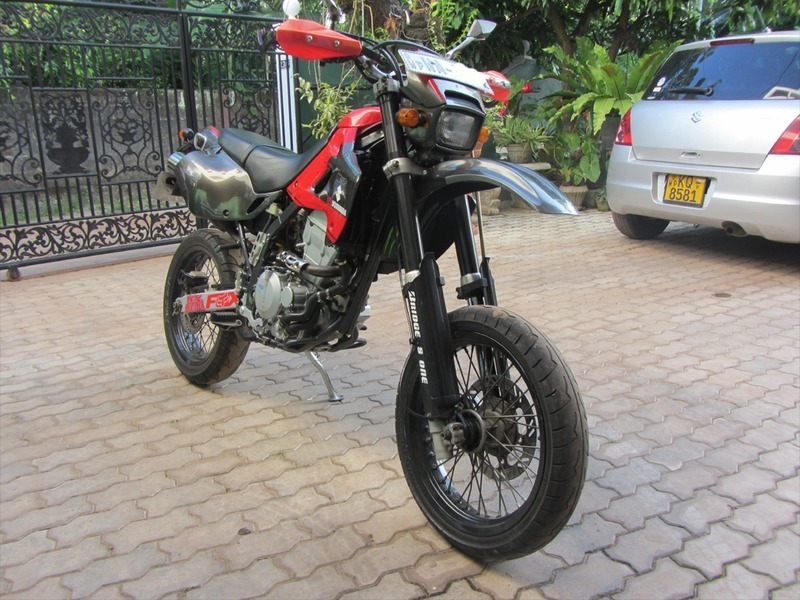Another early internal combustion, petroleum fueled motorcycle was the Daimler Reitwagen. It was designed and built by the German inventors Gottlieb Daimler and Wilhelm Maybach in Bad Cannstatt, Germany in 1885.[8] This vehicle was unlike either the safety bicycles or the boneshaker bicycles of the era in that it had zero degrees of steering axis angle and no fork offset, and thus did not use the principles of bicycle and motorcycle dynamics developed nearly 70 years earlier. Instead, it relied on two outrigger wheels to remain upright while turning.[9] The inventors called their invention the Reitwagen ("riding car"). It was designed as an expedient testbed for their new engine, rather than a true prototype vehicle.[10][11]
Many authorities have excluded steam powered, electric motorcycles or diesel-powered two-wheelers from the definition of a 'motorcycle', and credit the Daimler Reitwagen as the world's first motorcycle.[12][13][14] Given the rapid rise in use of electric motorcycles worldwide,[15] defining only internal-combustion powered two-wheelers as 'motorcycles' is increasingly problematic.
If a two-wheeled vehicle with steam propulsion is considered a motorcycle, then the first motorcycles built seem to be the French Michaux-Perreaux steam velocipede which patent application was filled in December 1868,[10][11] constructed around the same time as the American Roper steam velocipede, built by Sylvester H. Roper Roxbury, Massachusetts,[10][11] who demonstrated his machine at fairs and circuses in the eastern U.S. in 1867,[8] and built a total of 10 examples.[14]
8900.00 $
8317.05 EUR
7092.41 GBP
7092.41 GBP
Reserved
Condition: New
Transaction: Exchange
Suzuki GD330 - new!
Another early internal combustion, petroleum fueled motorcycle was the Daimler Reitwagen. It was designed and built by the German inventors Gottlieb Daimler and Wilhelm Maybach in Bad Cannstatt, Germany in 1885.[8] This vehicle was unlike either the safety bicycles or the boneshaker bicycles of the era in that it had zero degrees of steering axis angle and no fork offset, and thus did not use the principles of bicycle and motorcycle dynamics developed nearly 70 years earlier. Instead, it relied on two outrigger wheels to remain upright while turning.[9] The inventors called their invention the Reitwagen ("riding car"). It was designed as an expedient testbed for their new engine, rather than a true prototype vehicle.[10][11]
Many authorities have excluded steam powered, electric motorcycles or diesel-powered two-wheelers from the definition of a 'motorcycle', and credit the Daimler Reitwagen as the world's first motorcycle.[12][13][14] Given the rapid rise in use of electric motorcycles worldwide,[15] defining only internal-combustion powered two-wheelers as 'motorcycles' is increasingly problematic.
If a two-wheeled vehicle with steam propulsion is considered a motorcycle, then the first motorcycles built seem to be the French Michaux-Perreaux steam velocipede which patent application was filled in December 1868,[10][11] constructed around the same time as the American Roper steam velocipede, built by Sylvester H. Roper Roxbury, Massachusetts,[10][11] who demonstrated his machine at fairs and circuses in the eastern U.S. in 1867,[8] and built a total of 10 examples.[14]
Many authorities have excluded steam powered, electric motorcycles or diesel-powered two-wheelers from the definition of a 'motorcycle', and credit the Daimler Reitwagen as the world's first motorcycle.[12][13][14] Given the rapid rise in use of electric motorcycles worldwide,[15] defining only internal-combustion powered two-wheelers as 'motorcycles' is increasingly problematic.
If a two-wheeled vehicle with steam propulsion is considered a motorcycle, then the first motorcycles built seem to be the French Michaux-Perreaux steam velocipede which patent application was filled in December 1868,[10][11] constructed around the same time as the American Roper steam velocipede, built by Sylvester H. Roper Roxbury, Massachusetts,[10][11] who demonstrated his machine at fairs and circuses in the eastern U.S. in 1867,[8] and built a total of 10 examples.[14]
Published 9 years ago
Modified 8 years ago
2434 views
60 calls










Re: Question